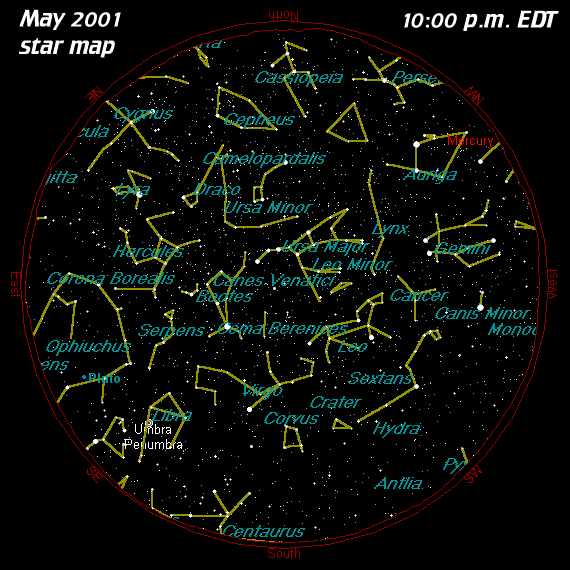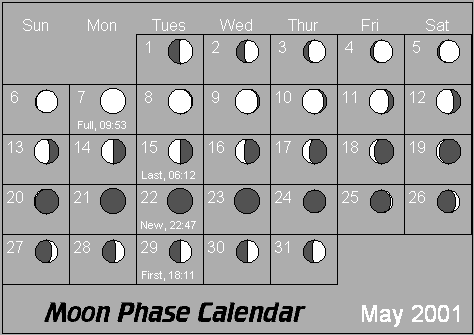Fly overs of the International Space Station as seen from Allentown
![[Location of the ISS]](ISS.gif) |
|
247  MAY 20, 2001:
Mars Returns
There is a strange new light becoming visible in the southeast if youíre an early morning stargazer. Itís bright and reddish, and it doesnít twinkle like the stars. If you were alive on Halloween Eve 1938, this planet would have made a lasting impression upon you, for it was the backdrop of the most famous radio hoax in the history of broadcasting, War of the Worlds. The Red Planet is again on the attack, currently gaining prominence in the east after midnight. But now its canals and Martians are just a historical footnote, a part of Marsí romantic past. As the weeks unfold into June, Mars will brighten and move westward in the opposite direction to its normal motion. This is an effect of a faster moving Earth catching up to Mars and passing it in just the same manner that a car or truck appears to travel backwards when you pass it on a highway. In astronomy this is called retrograde motion, and it will cause Mars to rise earlier than expected each evening. By early June, Mars will be visible low in the southeast at 11 p.m., but by mid-month, Marsí presence in the sky will be easily noticed by late twilight. By mid-July, Mars will be in the south as soon as itís dark and just slightly over five degrees from Antares, the brightest star of Scorpius, the Scorpion. Red Antares is Greek and means the rival of Aries. Aries was the Greek word for Mars, so the location of the Red Planet this summer next to Antares will be especially auspicious. Their location will be over the richest part of the Milky Way. However, Mars will dominate the scene, so observers will have an easy go at determining which objects are Mars and Antares. There will be more about Mars during June, or read ahead in the StarWatch section of the web address. MAY 20, 2001:
Mars Returns
There is a strange new light becoming visible in the southeast if youíre an early morning stargazer. Itís bright and reddish, and it doesnít twinkle like the stars. If you were alive on Halloween Eve 1938, this planet would have made a lasting impression upon you, for it was the backdrop of the most famous radio hoax in the history of broadcasting, War of the Worlds. The Red Planet is again on the attack, currently gaining prominence in the east after midnight. But now its canals and Martians are just a historical footnote, a part of Marsí romantic past. As the weeks unfold into June, Mars will brighten and move westward in the opposite direction to its normal motion. This is an effect of a faster moving Earth catching up to Mars and passing it in just the same manner that a car or truck appears to travel backwards when you pass it on a highway. In astronomy this is called retrograde motion, and it will cause Mars to rise earlier than expected each evening. By early June, Mars will be visible low in the southeast at 11 p.m., but by mid-month, Marsí presence in the sky will be easily noticed by late twilight. By mid-July, Mars will be in the south as soon as itís dark and just slightly over five degrees from Antares, the brightest star of Scorpius, the Scorpion. Red Antares is Greek and means the rival of Aries. Aries was the Greek word for Mars, so the location of the Red Planet this summer next to Antares will be especially auspicious. Their location will be over the richest part of the Milky Way. However, Mars will dominate the scene, so observers will have an easy go at determining which objects are Mars and Antares. There will be more about Mars during June, or read ahead in the StarWatch section of the web address.
248  MAY 27, 2001:
Moon Bright
There is something special about a full moon in the sky. Put some scudy, fast- moving clouds near it, a little chill in the air, and some distant lightning, and you have the setting for a hundred Hollywood horror flicks. The light of the full moon seems to tease the night into a deep twilight, revealing the landscapeís general features, but not that which lies within the shadows of our imagination. This week is a perfect time to watch the moonís light burgeon from its first quarter phase which occurs on Tuesday to its full phase which takes place one week later. During this period youíll watch the moonís light increase by tenfold, as it moves into a position which is opposite to the sun. Check out the increasing brightness of the moon. Youíll notice distinct shadowing on the ground, and itís fun to see where the shadows created by streetlights blend and are overpowered by the shadows being created by the moon. My grandfather used to reminisce about reading the newspaper by the light of the full moon when he was a soldier fighting in Russia during World War I. Keep in mind that this was during the winter with a snowcapped landscape. Try photographing the countryside under the light of the full moon. Youíll need a camera that can be controlled manually, a cable release, and a tripod. Try a fast film like Fujicolor 800 and take images in the range of F/2.8 to F/4.5, starting at 15 seconds. Continue doubling to 30s, 60s, 2 minutes, 4m, and there should be an acceptable photo within the lot. If the night is very clear, the sky will become a deep blue, and you will see stars also! See the authorís self-portrait taken under the light of a waxing crescent moon in todayís web version of this article. MAY 27, 2001:
Moon Bright
There is something special about a full moon in the sky. Put some scudy, fast- moving clouds near it, a little chill in the air, and some distant lightning, and you have the setting for a hundred Hollywood horror flicks. The light of the full moon seems to tease the night into a deep twilight, revealing the landscapeís general features, but not that which lies within the shadows of our imagination. This week is a perfect time to watch the moonís light burgeon from its first quarter phase which occurs on Tuesday to its full phase which takes place one week later. During this period youíll watch the moonís light increase by tenfold, as it moves into a position which is opposite to the sun. Check out the increasing brightness of the moon. Youíll notice distinct shadowing on the ground, and itís fun to see where the shadows created by streetlights blend and are overpowered by the shadows being created by the moon. My grandfather used to reminisce about reading the newspaper by the light of the full moon when he was a soldier fighting in Russia during World War I. Keep in mind that this was during the winter with a snowcapped landscape. Try photographing the countryside under the light of the full moon. Youíll need a camera that can be controlled manually, a cable release, and a tripod. Try a fast film like Fujicolor 800 and take images in the range of F/2.8 to F/4.5, starting at 15 seconds. Continue doubling to 30s, 60s, 2 minutes, 4m, and there should be an acceptable photo within the lot. If the night is very clear, the sky will become a deep blue, and you will see stars also! See the authorís self-portrait taken under the light of a waxing crescent moon in todayís web version of this article.
| |


| 



![[Location of the ISS]](ISS.gif)
![[Gary by Moonlight]](garymoon.jpg)

